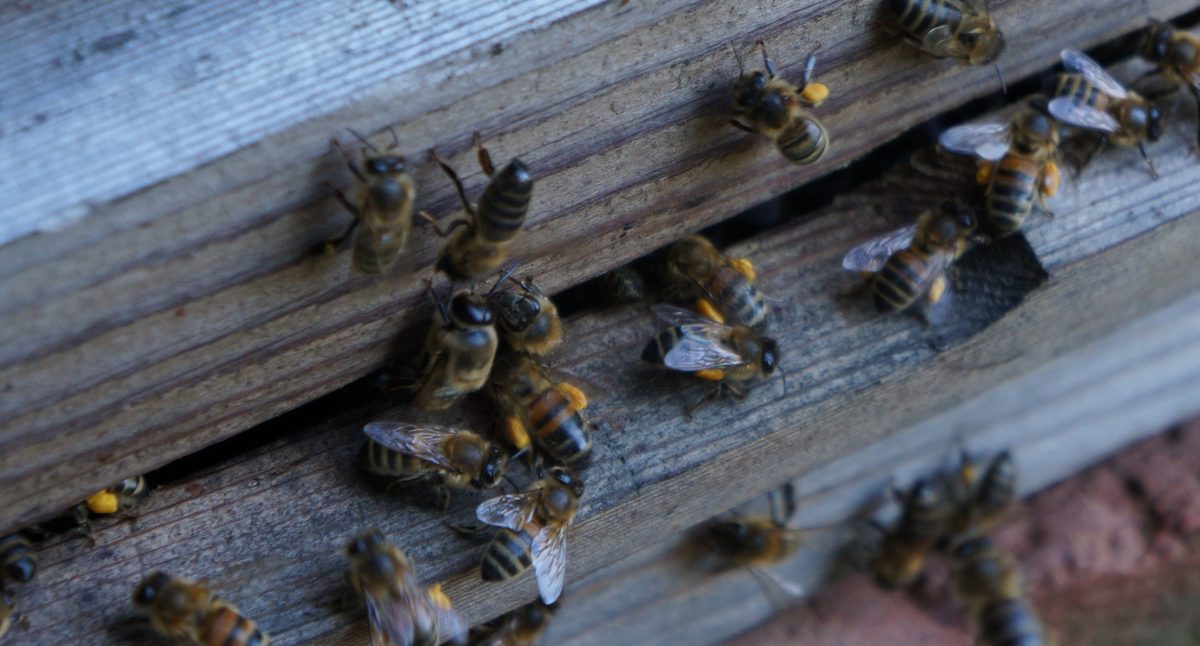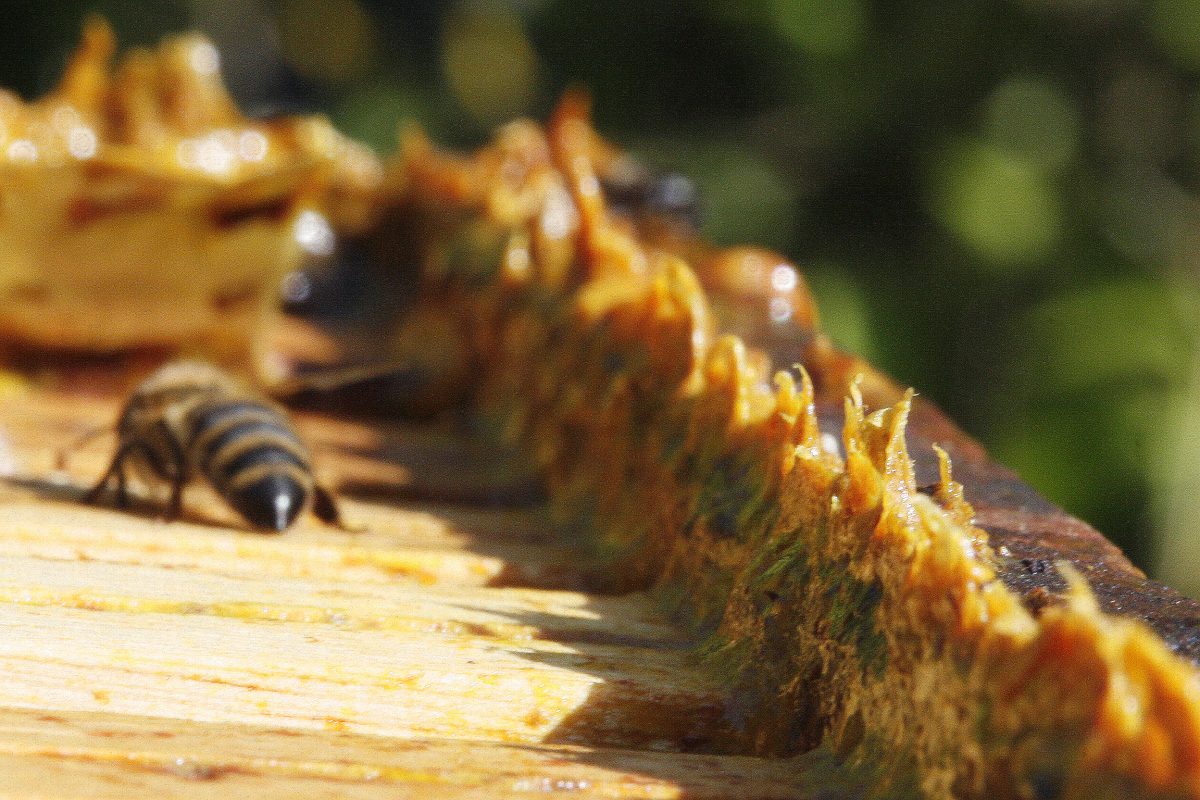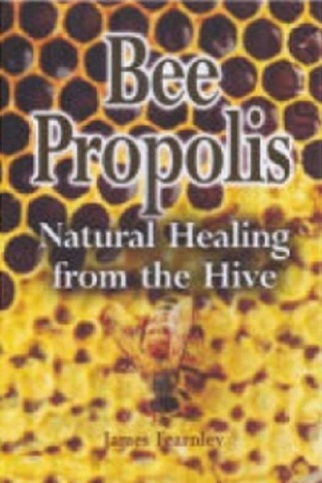 Abraham Lincoln
If given the truth, the people can be depended upon to meet any national crisis...
Abraham Lincoln
If given the truth, the people can be depended upon to meet any national crisis...
 Guildford news...
for Guildford people, brought to you by Guildford reporters - Guildford's own news service
Guildford news...
for Guildford people, brought to you by Guildford reporters - Guildford's own news service
Beekeeper’s Notes October 2016: Natural Healing From The Hive
Published on: 1 Oct, 2016
Updated on: 4 Nov, 2016
Hugh Coakley keeps bees in Worplesdon. In the latest of his monthly notes, he talks about propolis, the little known substance in the hive but with well documented healing properties.
The bees are very busy considering it is the back end of September. The Indian Summer sees the hive urgently getting in the last of the stores to take them through the winter.

Busy hive with plenty of pollen going in even at this late stage in the year. The queen is still laying strongly. Click to enlarge.
The honey has now been harvested. Not a bad year for me, not the best but good.

Lots of activity at the hive entrance for the end of September. I have harvested honey from this hive – about 60lbs – but I have left enough in the hive for them to go through the winter. I have been also feeding them just to make sure that they have enough.
Honey is not the only produce that we can gather from our bees. Beeswax is well known but less so is ‘propolis’.
This is the sticky glue that bees use to seal up cracks and to give an antiseptic and structural lining to the combs before the queen lays her eggs. The bees also use it where there is a large dead invader such as a mouse. The bees can’t remove it from the hive so they entomb it in propolis, mummifying it.

Propolis on the frames and on the edge of the hive box, brown and sticky. The bees seal up cracks and we can scape it off to harvest it. You only get minute quantities, maybe 30g or so, from a hive. There are techniques for encouraging the bees to produce propolis in greater quantities. Click to enlarge.
Propolis is broadly made up from about 50% resins from tree buds, 30% waxes, 10% essential oils from plants and about 5% pollen.
It sounds straightforward but it is definitely not with up to 150 distinct compounds having been identified in its makeup. It varies between areas and individual hives and even within hives themselves.
The name is from the Greek. Pro (before) polis (city) – ‘before the city’ or ‘defender of the city’ as it was commonly found at the hive entrance. The bees use it to limit the size of the entrance and also, it is said, to have an antiseptic doormat to keep disease at bay.

A thick strip of propolis along the edge of the hive. There must have been a large gap for the bees to seal. Click to enlarge.
We read about people chewing propolis to help with toothache, as an ointment to aid wound healing, as an additive to medicated wine and various other curative uses.
The Romans used it reduce swelling, sooth pain and heal sores and later references in herbal medicine books claim it is “..singularly good for all heat and inflammation in any part of the body and tempers the heat of wounds”.
In Eastern Europe, propolis is commonly used as a natural remedy for the flu, colds and sore throats and many take it daily as a natural immune booster.
I am reading a book at the moment Bee Propolis – Natural Healing from the Hive, by a chap called James Fearnley. He claims propolis is an anaesthetic, antibiotic, anti-fungal, anti-inflammatory, antiseptic and even antiviral and anti-tumour / cancer. You can see him on YouTube giving a talk (click here)
Possibly taking his enthusiasm too far but who can tell?
He talks about how western scientists have tried to single out the active ingredient in propolis. He feels that they are missing the point though. It is not one ingredient that makes it so effective but propolis as a complex substance, he thinks, working all together.
One by one, our antibiotics have been outsmarted by clever bacteria. That hasn’t happened with propolis. Is propolis, and natural products like propolis, the answer to the modern day crisis in antibiotics? He thinks it is.
He concludes “In the case of propolis, necessity will be the mother of re-invention as the deepening crisis encourages us to revisit the medicines of the past with all the real benefits of the science of today”.
I’m not convinced but I would love for him to be right!
Recent Articles
- Updated: Gas Company Discovered Leak Necessitating ‘Emergency’ Works and Road Closure
- Borough Council Hears Plea to Take a Moral Stand Over Gaza
- Dragon Review: By Royal Appointment – Yvonne Arnaud Theatre
- Notice: Visit Burpham’s Community Cafe
- Letter: Gas Company Is Taking Residents and the Council for Idiots
- Is GBC Britain’s Most Wasteful Council? Asks National Paper
- Letter: Police Performance Issues I Encountered Were Administrative, Not Operational
- Loseley House Closed for ‘Gentlemanly’ Filming
- Opening 3-0 Loss for City But Scoreline Does Not Tell the Whole Story
- Letter: Worplesdon Parish Council – Only Guilty of Being Good



Search in Site
Media Gallery
Dragon Interview: Local Artist Leaves Her Mark At One of England’s Most Historic Buildings
January 21, 2023 / No Comment / Read MoreDragon Interview: Lib Dem Planning Chair: ‘Current Policy Doesn’t Work for Local People’
January 19, 2023 / No Comment / Read MoreA3 Tunnel in Guildford ‘Necessary’ for New Homes, Says Guildford’s MP
January 10, 2023 / No Comment / Read More‘Madness’ for London Road Scheme to Go Ahead Against ‘Huge Opposition’, Says SCC Leader
January 6, 2023 / No Comment / Read MoreCouncillor’s Son Starts Campaign for More Consultation on North Street Plan
December 30, 2022 / No Comment / Read MoreCounty Council Climbs Down Over London Road Works – Further ‘Engagement’ Period Announced
December 14, 2022 / No Comment / Read MoreDragon Interview: GBC Reaction to the Government’s Expected Decision to Relax Housing Targets
December 7, 2022 / No Comment / Read MoreHow Can Our Town Centre Businesses Recover? Watch the Shop Front Debate
May 18, 2020 / No Comment / Read More












Recent Comments